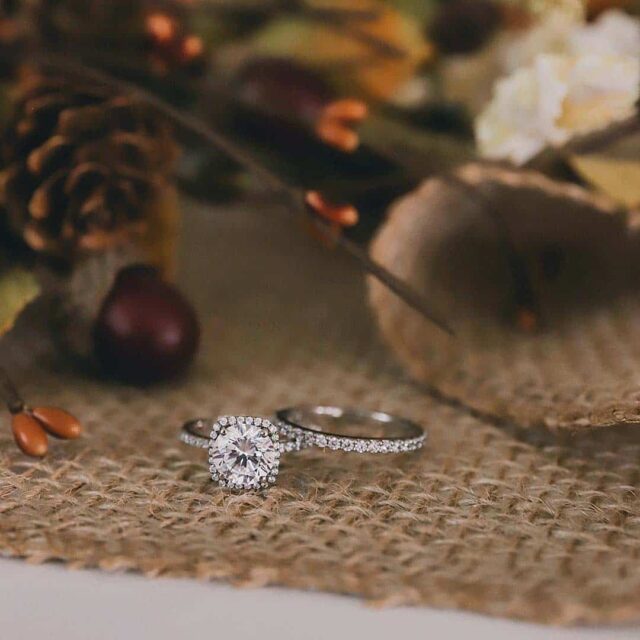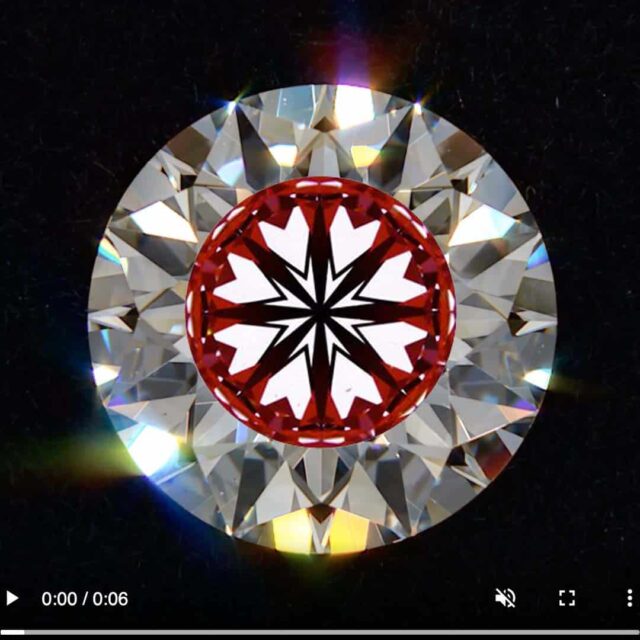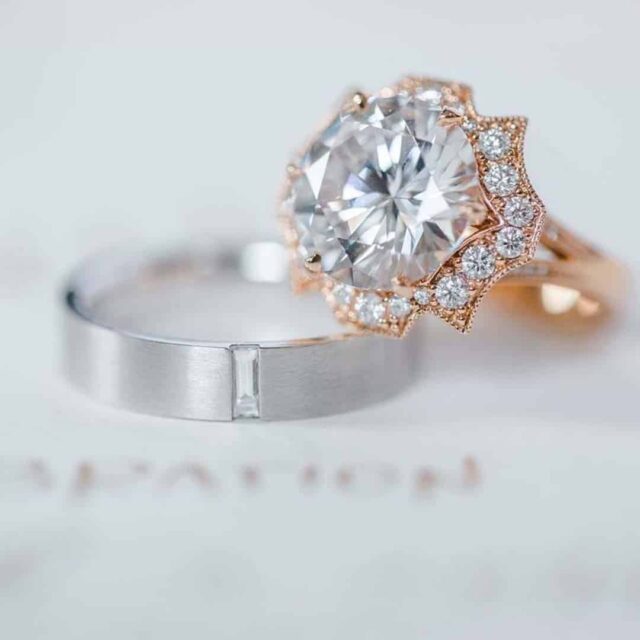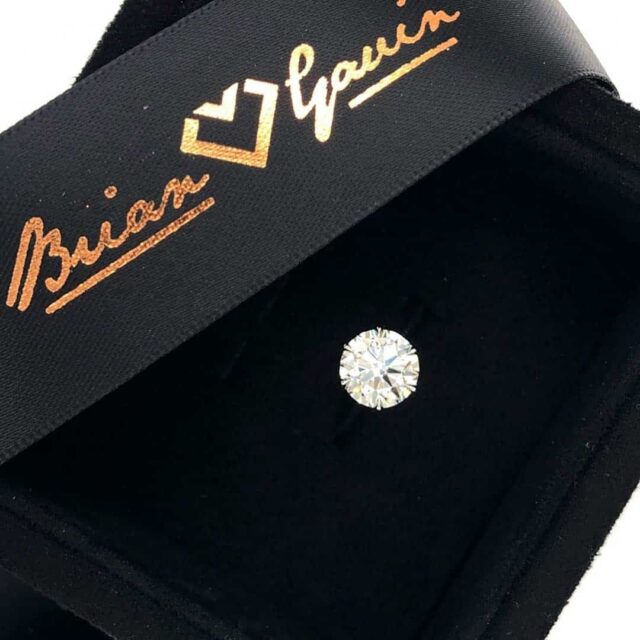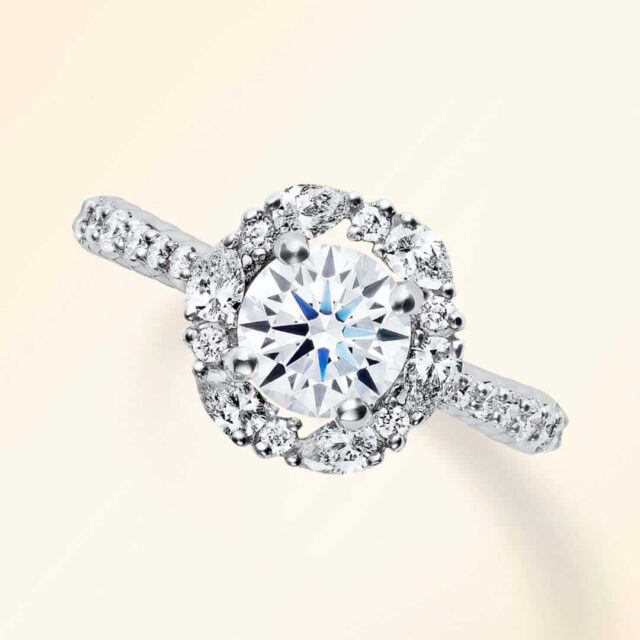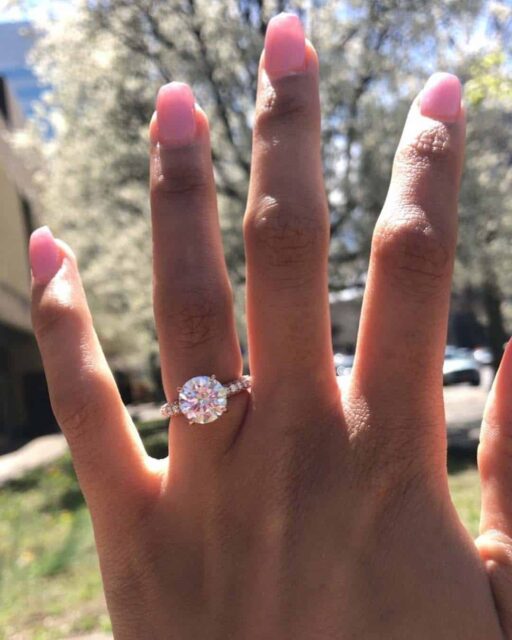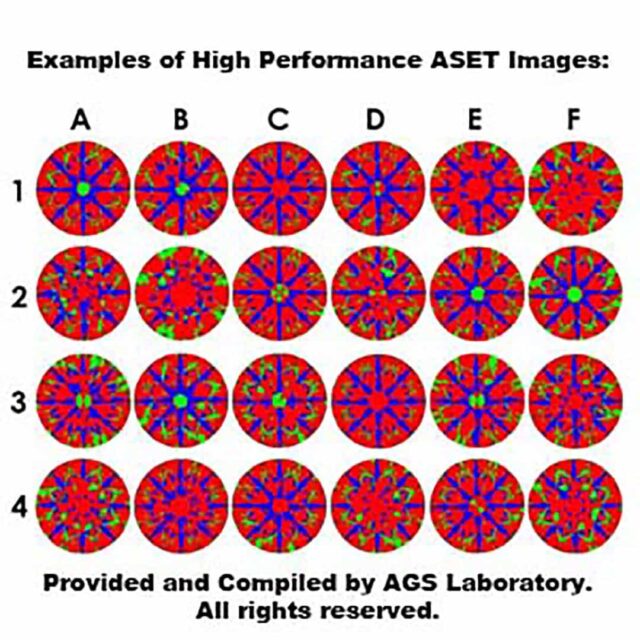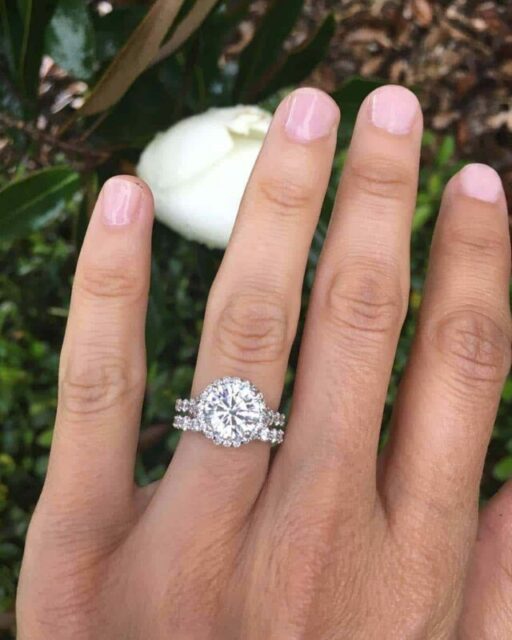Ideal cut diamonds offer the highest degree of light return and superior light performance. Consequently, a poorly cut diamond cannot sparkle well because it’s less than ideal.
Unfortunately, there is more than one definition of an ideal cut diamond. Most those parameters do not meet our selection criteria. That's because the zero ideal proportions rating encompasses a broad range or spectrum of possibility.
In that case, most AGS Ideal and GIA Excellent grade diamonds don't make the cut. In other words, they aren't likely to exhibit the best light performance.
The purpose of this tutorial is to teach you how to pick the best-looking ideal cut diamonds. We have 35+ years experience in the niche of light performance.
In that case, we have the knowledge and resources to guide you through the process. In addition, you can use our free diamond concierge service and let us conduct the search. We can also help you select the perfect setting, like the James Allen Cushion Halo setting above.
How to Pick the Best Ideal Cut Diamonds:
Contrary to what you might be led to believe, there is more to buying ideal cut diamonds than meets the eye. As a matter of fact, simply limiting your search to AGS Ideal or GIA Excellent cut diamonds isn't good enough.
After all, the range of proportions that they consider ideal is too broad. In addition, the degree of optical precision should also be taken into account. Unfortunately, optical precision is not part of the grading criteria for the AGS Ideal-0 or GIA Excellent grades.
In that case, it's up to you to judge the degree of optical precision for yourself. Consequently, the only way to do that is to examine the diamonds using various scopes designed for that purpose.
In this case, we overlaid the hearts pattern of a Brian Gavin Signature diamond. The purpose is to demonstrate the connection between optical precision and sparkle factor. As you may recall, optical precision is the consistency of facet shape, size, and alignment from the perspective of 360-degrees.
Conversely, you can't have a good looking hearts pattern without exceptional optical precision and vice versa. In that case, the presence of a crisp and complete H&A pattern is an indication of optical precision. Consequently, the ASET and Ideal Scope images for this diamond also look phenomenal.
Ideal Proportions for Performance:
Obviously, the proportions of a diamond are a critical component for light performance. As a matter of fact, the pavilion angle determines the volume of light return. That is the the lower portion of a diamond that reflects light back up towards the observer.
At the same time, the crown angle will determine the balance of brilliance and dispersion. That is the white and colored sparkle that is also known as dispersion or fire.
The crown is the upper half of the diamond and it also affects the size and intensity of the sparkle factor. In addition, the size of the table facet is also a critical factor of light performance.
After all, if the table size is too large or too small, then it can result in light leakage and poor light performance. The table facet is the large flat facet that appears on top of a diamond.
The table facet is easy to see in this photograph of an 8.10 carat, Signature diamond. As a matter of fact, this is the flagship of the Brian Gavin 810 Collection.
A properly optimized diamond exhibits a high volume of light return and a virtual balance of brilliance and dispersion. Assuming that is what you're looking for, then we recommend the following set of proportions. Because it's the most likely to deliver the highest volume of light return and a balance of sparkle factor.
The Proportions We Recommend:
This set of proportions falls within the middle of the spectrum designated for the zero ideal cut proportions rating. Ideal diamonds with these proportions, and an overall cut grade of AGS Ideal-0 or GIA Excellent, that exhibit a crisp and complete pattern of hearts and arrows are commonly known as super ideal cut diamonds.
Of course, there are other ranges of proportions and performance to consider. We provide more information on that in the One Minute Diamond Buying Guide.
Classifications of Ideal Cut Diamonds:
The term "ideal cut diamonds” is used to describe a wide variety of options. As a matter of fact, it's become a catch phrase that encompasses a broad range of options. The majority of which seem to be far from what I personally consider to be ideal. Obviously, that is one of the things that I hope to straighten that out.
In the first place, I don’t agree with the broad range of proportions parameters that the AGS and GIA suggest. Obviously, the range of proportions is much too broad. As a result, there are a lot of "ideal cut diamonds" that exhibit substandard performance. In other words, they exhibit a lot of light leakage, obstruction and poor contrast brilliance.
In the first place, I don’t agree with the broad range of proportions parameters that the AGS and GIA suggest. Obviously, the range of proportions is much too broad.
As a result, there are a lot of "ideal cut diamonds" that exhibit substandard performance. In other words, they exhibit a lot of light leakage, obstruction and poor contrast brilliance.
The conspiracy theorist in me is convinced that these organizations have succumbed to industry pressure to make it easier to hit the AGS Ideal-0 and GIA Excellent cut grades.
The fact that GIA makes a practice of rounding off some of the measurements provided on their diamond grading reports, after averaging those measurements to begin with is patently absurd.
Classifying ideal cut diamonds as such when they have a polish or symmetry grade of very good is equally absurd. If a diamond has a polish or symmetry grade of very good, it is not ideal cut by my standards. Accept nothing less than AGS Ideal or GIA Excellent with proportions as outlined above.
Hearts and Arrows Super Ideal Cut Diamonds:
In addition, you might enjoy reading about the creation of hearts and and arrows patterns. As a matter of fact, there are a lot of underlying conditions that determine whether a diamond is hearts and arrows. Be that as it may, it would be a lot to cover in this tutorial. Especially since this article on hearts and arrows diamonds explains it all in-depth.
AGS Ideal-0 Cut Diamonds:
To begin with, this tutorial on AGS Ideal Cut Diamonds covers the subject in great detail. Obviously, I strongly recommend adhering to the range of proportions presented above. In addition, I recommend the grading report that features the ASET map. After all, that provides a visual representation of light performance.
Without the ASET scan, you won’t be able to determine how evenly light is being reflected throughout the diamond. Consequently, the ASET image on the left is courtesy of the AGS Laboratory.
The right side of the image shows how the diamond looks as seen through an ASET Scope. It makes it possible to see how evenly light is reflecting throughout the diamond.
At the same time, the ASET indicates how bright the diamond will be. In addition to showing us where the diamond is gathering light from within the hemisphere. And the degree of contrast that is present to create the depth of field.
The Key to Unlocking Peformance:
A lot of dealers hate the insight of ASET technology. The reason should be obvious because it shows how poorly their diamonds perform. Although that may be true, I'm not rubber stamping the AGS Ideal-0 cut grade.
In the first place, the proportions parameters are too broad. In addition, I've seen a lot of ASET images that give me pause. As a matter of fact, sometimes I find myself staring at an ASET image and wondering... How on earth did this diamond make the grade?
In fact, sometimes I shoot a copy of the lab report over to friends of mine just for a laugh. Obviously, they share my insane passion for light performance. Under those circumstances, I know that they're going to laugh and roll their eyes. However, they are also likely to express their frustration about the slippery slope of grading standards.
GIA Excellent Cut:
As a matter of fact, it is questionable whether we should describe GIA Excellent cut diamonds as ideal. After all, the GIA grading platform does not include an ideal cut rating.
In fact, the highest rating available from the GIA is Excellent not Ideal. Under those circumstances, perhaps we shouldn't refer to GIA Excellent cut diamonds as ideal because they're not.
In addition, most of the diamond cutters that I know prefer the grading standards of the AGS Laboratory. To begin with, the AGS Laboratory measures diamonds using a more reliable method.
Secondly, they don't round off the measurements in the same way that the GIA does. For those reasons, many trade members do not consider GIA Excellent and AGS Ideal cut diamonds to be comparable.
In that case, they adamantly reject the idea of referring to GIA Excellent as ideal cut. As a result, they toss them into their own classification of GIA Excellent cut diamonds.
Are GIA Excellent Diamonds Ideal Cut?
As a matter of fact, a lot of GIA Excellent diamonds might not not receive an overall cut grade of AGS Ideal-0. The stumbling block that trips up a lot of diamonds is the ASET scan.
The AGS Laboratory also adheres to a tighter proportions range than those that the GIA relies upon. There is also the fact that the GIA rounds off some of the measurements provided on their diamond grading report.
Consequently, the AGS reports the average of eight measurements per section. The GIA takes measurements the same way, but then they round off the averages.
Obviously, I do not feel that this necessarily eliminates GIA Excellent cut diamonds from the ideal classification. After all, the standards for polish and symmetry are comparable.
In addition, a lot of GIA graded diamonds have proportions within the range I recommend. Consequently, I object to the practice of rounding off the average measurements, especially to the extent the GIA applies.
Fine-tuning the Proportions:
In order to know the proportions for certain, you'll need to obtain a manufacturers Sarin | OGI | Helium report. Unfortunately the majority of online dealers will not provide you with more than the basic version of the report. Consequently, that version of the report is essentially useless.
With that in mind, If I were considering diamonds graded by the GIA, then I would only consider options with an overall cut grade of GIA Excellent. In addition, I would insist that the proportions be within the range outlined above. As a matter of fact, I wouldn't consider anything less. After all, I'm looking for the highest volume of light return and a balance of brilliance and dispersion.
At the same time, I would insist on ASET and H&A Scope images of the diamond. And I do mean actual images, as in actual photographs. Not the picture perfect computer generated renderings that I see popping up all over the place! Those are not accurate representations of the diamond.
As a matter of fact, those computer generated renderings are based solely upon the proportions. In that case, can't possibly account for light leakage. In addition, they can be easily manipulated to improve the perception of performance.
Although that may be true, the ASET map on the lab report provides valuable insight. As you can see from the ASET images on the left, there can be dramatic differences in light performance.
EGL Tolkowsky Cut:
Generally speaking, it's not likely that the EGL Tolkowsky grade is going to meet my standards. Not only is the range of proportions that they adhere to well beyond the range defined by Marcel Tolkowsky's Diamond Design.
However, there is also a lot of debate about the grading standards of this laboratory. In other words, a lot of people don't feel that their grading standards are comparable to the AGS or GIA.
As a matter of fact, the RapNet Diamond Exchange banned EGL graded diamonds in October of 2014. In addition, a series of class action lawsuits were filed against jewelers who sold EGL graded diamonds.
The claim being that the diamonds were mis-represented due to being over-graded. Several of the jewelers targeted by that lawsuit referred to it as extortion. Be that as it may, the issue was eventually resolved out of court.
The 60/60 Ideal Cut Diamond:
As a matter of fact, the 60/60 ideal cut diamond is a bit like the mythical unicorn. Be that as it may, we're going to kill the myth right here. After all, the assumption that a diamond is ideal cut simply because it has a 60% table diameter and a 60% total depth is patently absurd.
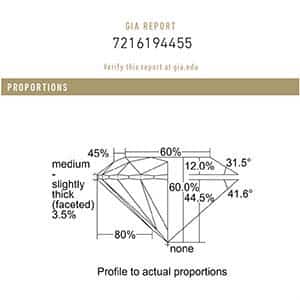
60/60 Ideal Cut Diamond.
So that we're clear, there are so-called diamond experts who promote the idea that a diamond with a 60% total depth and table diameter is ideal cut. In other words, the table diameter and total depth measurements are both sixty percent. In that case, they claim that the crown and pavilion sections will (somehow magically) be just right.
As a matter of fact, that kind of logic (or lack thereof) is just plain stupid. Obviously, there are a lot of ways that the total depth of that diamond can be divided. As a result, I've seen a lot of 60/60 diamonds with proportions far from ideal.
Proving my point is as simple as conducting a search for AGS and GIA 60/60 Ideal Cut Diamonds. In other words, search for diamonds with a 60% total depth and table diameter. Then look at the wide range of offsets for crown/pavilion angle.
Case In Point:
This GIA Excellent cut diamond above has a total depth and table diameter of 60%. In that case, it falls into the classification commonly known as the 60/60 ideal cut diamond.
Technically I suppose that statement is accurate (sarcasm). After all, a diamond with these proportions does fall within the 2012 AGS proportions guidelines for diamonds. At least those with a 60% table diameter which they consider to be a class of their own. Be that as it may, it doesn’t make the diamond Ideal Cut by my standards.
A Picture Is Worth 1000 Words:
Take a look at the photograph of the 60/60 ideal cut diamond below. Does the diamond show a pattern of light return that is evenly distributed throughout the diamond? Is light reflecting evenly off the facets? Does the diamond exhibit excellent contrast brilliance?
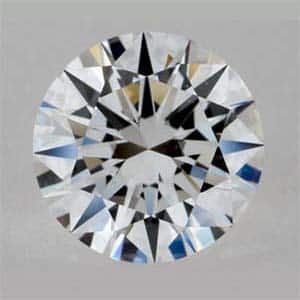
60/60 Ideal Cut Diamond.
As a matter of fact, the answer to all those questions is no. That's because the crown angle is too shallow. At the same time, the pavilion angle is too steep and that combination creates chaos.
Consequently, a pavilion depth of 43.5% is the critical tipping point where light begins not to strike fully off the pavilion facets. In this case, the pavilion depth is 44.5% which is one full percent past that point.
Clearly the crown and pavilion sections of a diamond will not automatically be correct, simply because the diamond has a total depth and table diameter of 60%. So much for the ideal of 60/60 ideal cut diamonds.
As with every other diamond cut in the world, it is a matter of finding one with the right proportions. I can tell you from experience, it’s like looking for the infamous needle in a haystack. The odds of finding ideal cut diamonds that fall within the range of parameters outlined above is significantly higher.
Let Us Help You Find the Perfect Diamond:
Obviously, there is a lot to know about buying a diamond. We hope that the information contained in this ideal cut diamonds buying guide was helpful.
We'd like you to know that you're not alone on this journey. Because we're happy to assist you with your search and answer any questions that you might have.
With that in mind, we invite you to take advantage of our Diamond Concierge Service. There is no charge for our service and it will not affect your price. As a matter of fact, the price is the same whether you find it on your own or let us help you.
Of course, our 35+ years of experience will make it much easier for you all the way around. In addition, we're happy to assist you whether you are buying online or from a local jeweler.
That's because we work on the premise from this quote by Zig Ziglar: "You can have everything in life you want, if you will just help enough people get what they want."

